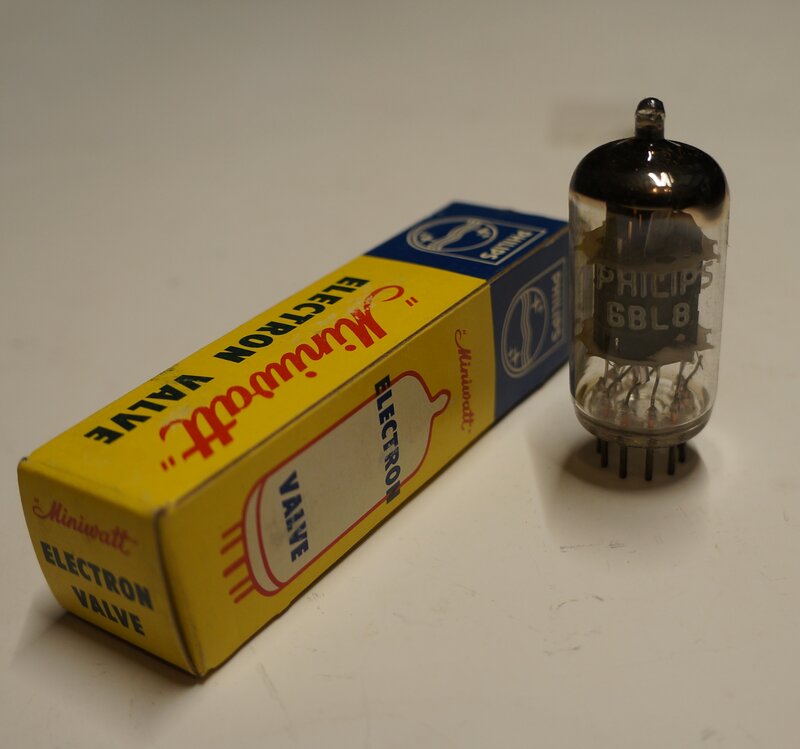
Useful and versatile, the 6BL8 has many applications.

Useful and versatile, the 6BL8 has many applications.
Any Australian who collects valves or is into vintage television will have copious quantities of 6BL8's. Sadly, they are usually regarded as worthless (and in the radio world, useless). Yet, they are one of the most versatile valves, usable in so many applications.
The 6BL8 is a 9 pin triode pentode, rated for VHF operation. It was originally designed by Philips for use as a TV tuner frequency converter, with the triode as the local oscillator, and the pentode as the mixer. Probably unbeknown to most Australians, the 6BL8 started life as the PCF80. This is a far more common valve in Europe and the UK, since series heater TV sets were standard there. This article will therefore also be of use to readers from Europe and Britain.
Prior to the PCF80, Philips had been using
the ECC81/12AT7 in their TV tuners, as the frequency converter. In 1954,
the PCF80 became available, providing superior performance in this role.
Designed for European television receivers,
the PCF80 was intended for 300mA series heater circuits. The heater voltage
is 9V. In the RMA valve numbering system, this valve is known as the 9A8.
Curiously, this valve also appears as an 8A8, despite the 9V heater.
Another less common variation is the LCF80/6LN8.
This is specifically for 450mA series heater circuits, and was used in
some Japanese TV sets.
Since transformer isolated power supplies were standard in Australia, the PCF80 was also available with a 6.3V heater, as type ECF80. In Australia, the ECF80 is more widely known under the RMA type number, 6BL8. Depending on the data, the heater current at 6.3V is shown as either 430mA or 450mA. Despite 450mA being a standard heater current in some series circuits, the 6BL8 is not designed for series heater use.
When TV started in Australia, in 1956, the 6BL8 found itself in just about every set that was not based on U.S. designs. Most commonly, it was used in the Philips tuner, type AT7580, and the later version, type NT3001. These tuners were used in many sets; not just Philips. Beyond that, the 6BL8 was also used for line oscillators, sync separators, IF amplifiers, AGC circuits, and in fact anywhere that a signal type pentode and/or triode was required.
Outside of television use, the 6BL8 also
appeared in test instruments, such as oscilloscopes and voltmeters. No
commercially made domestic radio receivers are known to have used it in
Australia, but it was used in FM receiver front ends in Europe and Britain.
In the U.S., the 6BL8 did find limited
use, particularly in some colour TV's during the 1960's, but in that country,
a similar valve, the 6U8, was the dominant signal type triode pentode.
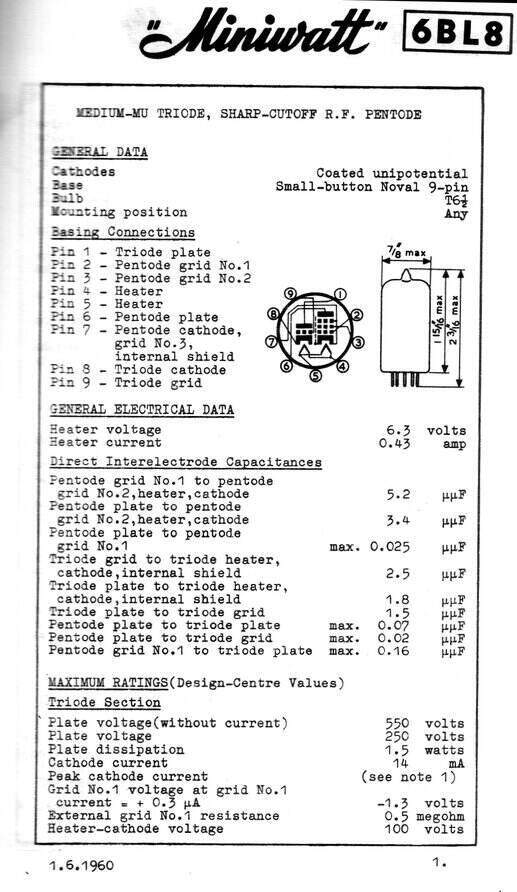
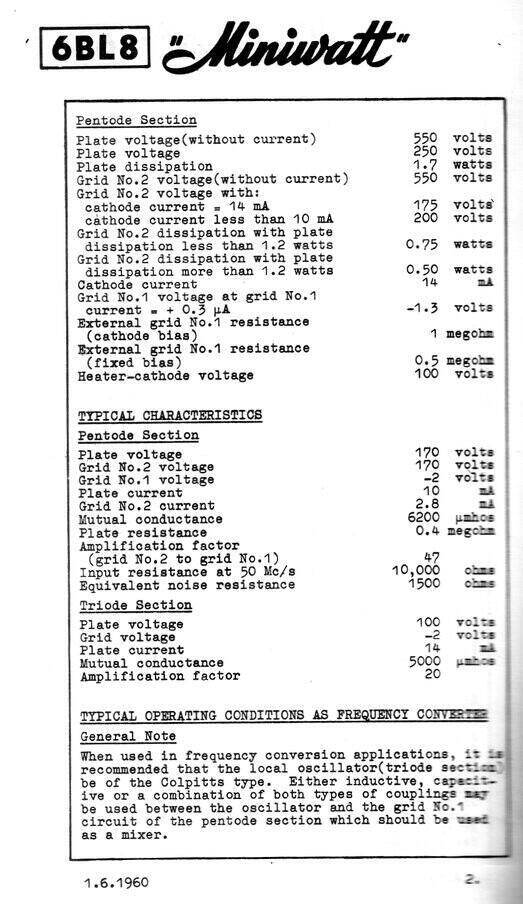
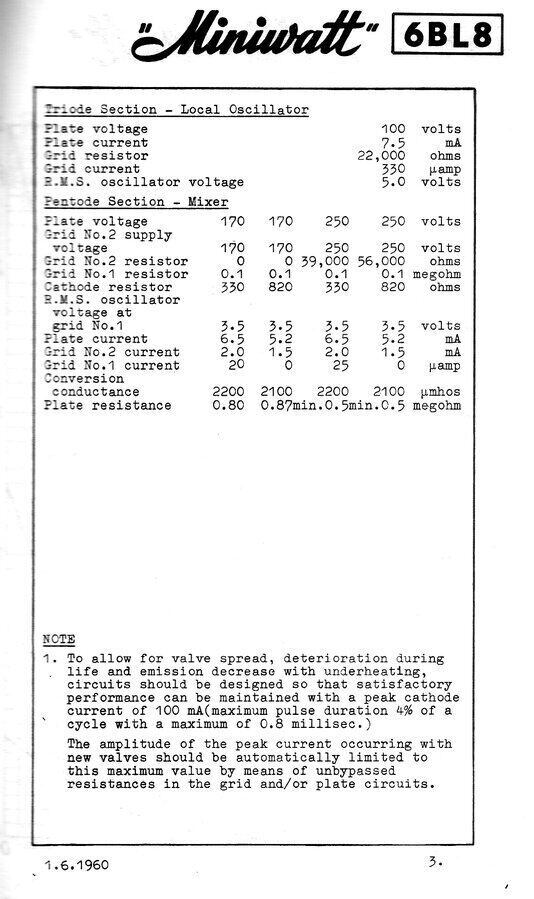
Data from the Australian "Miniwatt Electronics Handbook", 1965.
Television Applications.
Since these are so numerous, it is best
to see the article on the 6BL8, as published in the 1956 Philips publication,
"Miniwatt Receiving Valves and Picture Tubes for Australian Television
Receivers". This article also includes detailed data and curves on the
6BL8.
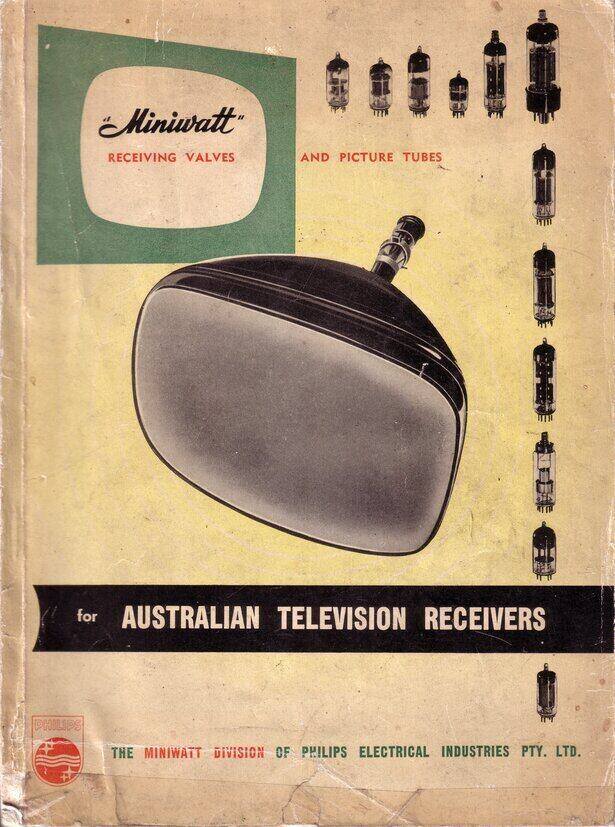
Applications described are:
Other Philips data includes a vague reference
concerning the use of the triode as a frame output valve. It would be imagined
that the 6BL8 triode would only be capable of deflecting low angle picture
tubes; 70 degrees or less, but no actual data or circuits have been found.
The following was taken from the PCF80 data in "Philips Receiving Tubes",
part 4, 1972:

Note that this is also referred to in
the above Miniwatt data (Note 1), but without any reference to frame output
use.
Audio Applications.
The 6BL8 makes a compact audio amplifier
for small receivers, where not a lot of output power is required. This
first circuit is from one of my Pulse Counting FM receivers. It produces
about 300mW output power.
The output transformer was a 240V to 6.3V
300mA type, since mains isolation was required.
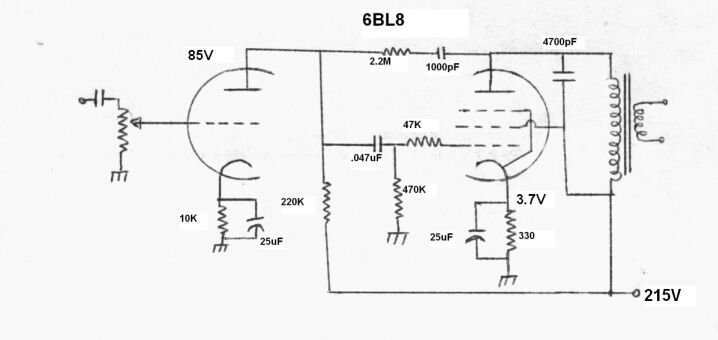
The next circuit is of a signal tracer
which I designed and built in 1990. Modern low voltage transformers were
used back to back to obtain the B+. The speaker transformer is also another
mains transformer, type 2851. A diode probe (not shown) allowed for tracing
of RF signals.
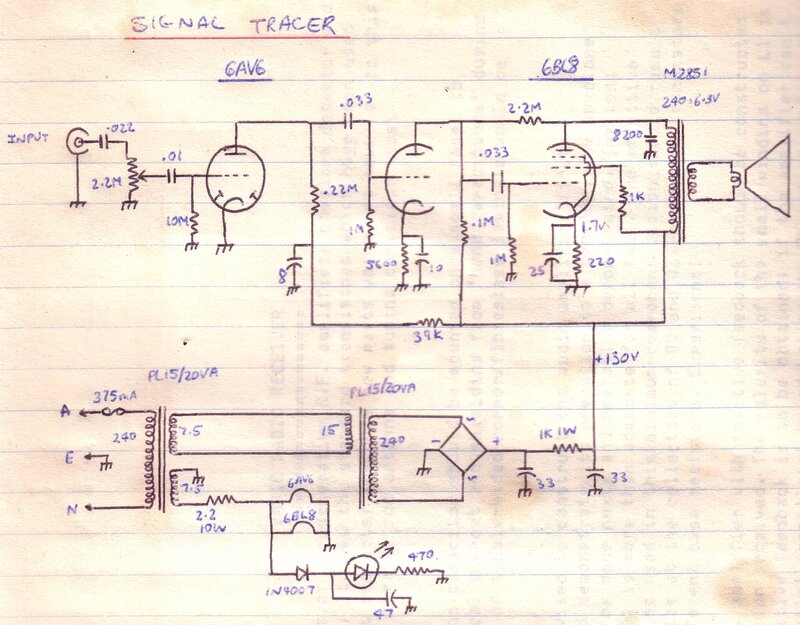
Signal tracer has 2mV sensitivity. Output is 200mW.
At least two British TV manufacturers,
Thorn and STC, used the PCF80 as a complete audio stage. Below is the circuit
from a Thorn 980 chassis. See "Practical Television", December 1967. If
this circuit is to be used in other applications, note that the volume
control is between the triode and pentode. Therefore, input signal to the
triode must not be so high as to overload it. Speaker transformer impedance
calculates to about 20K.
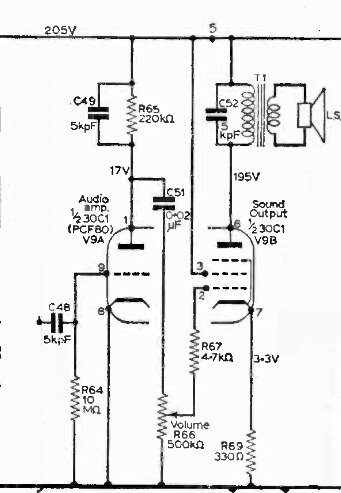
PCF80 in the Thorn 980 chassis.
Thorn also used the PCF80 in the later 1580 chassis, as shown below. See "Practical Television", June 1973. Note that the 600R shown for the speaker transformer is the DC resistance. The impedance is much higher. With about 10mA plate current and 216V on the plate, the ideal impedance would be around 22K. Note that the C56-R84 network would provide a severe roll off for the higher audio frequencies, and should be modified or removed if this circuit is used for other applications.
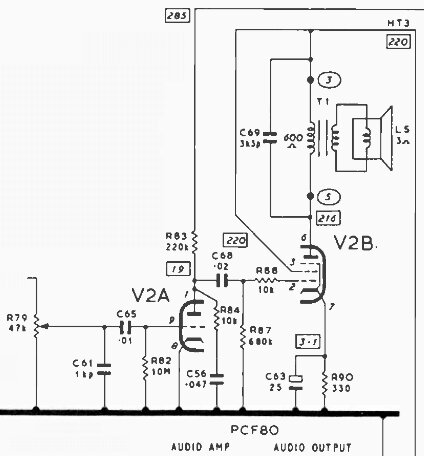
PCF80 used in the Thorn 1580 chassis.
STC used a PCF80 in their 11" Portable
VC11. B+ is 245V.
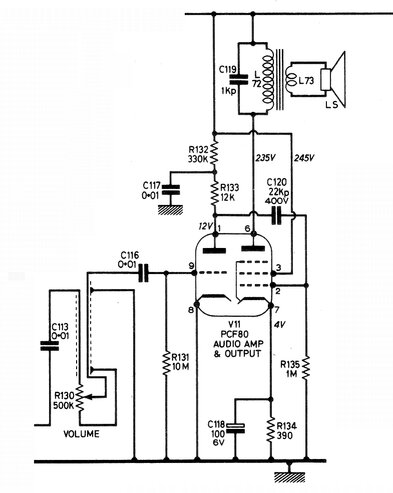
STC used a PCF80 in an 11" portable.
This was shown in Practical Television
for October 1969. Again, we see a high frequency roll off network, consisting
of R132 and C117.
In each of these three circuits, contact
bias is used for the 6BL8 triode. This is unusual, because contact bias
is more suited to high mu triodes, such as 12AX7 and 6AV6. The 6BL8 triode
is medium mu, and as such, the bias generated by this method is quite low.
This is reflected in the low plate voltage; 12 to 19V in the circuits shown.
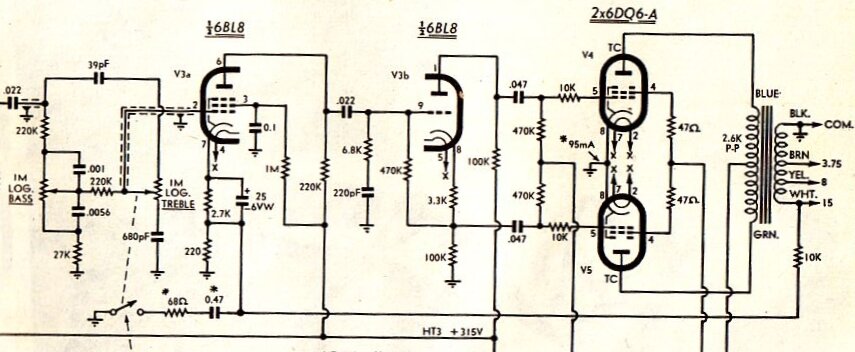
Headphone Amplifier.
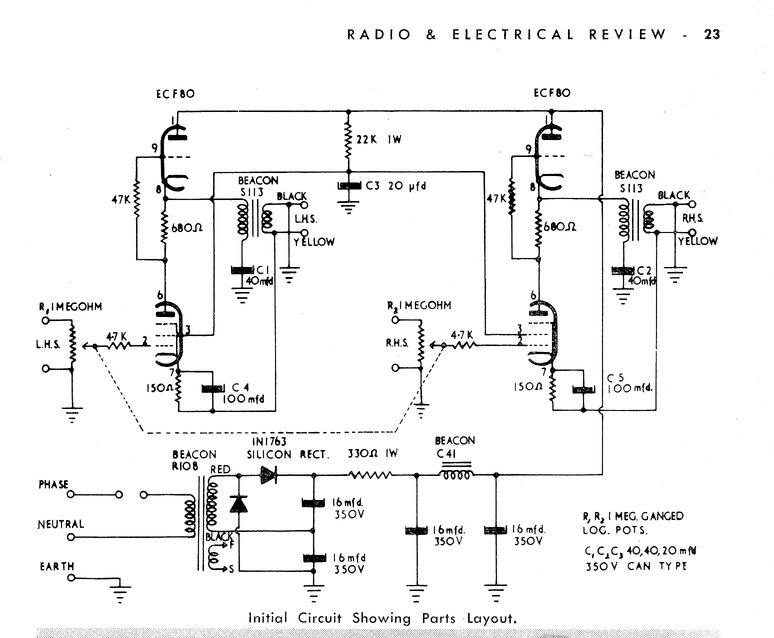
This headphone amplifier design came from
the NZ "Radio & Electrical Review", March 1962. Unfortunately, very
little detail was included. Beacon was an Auckland based transformer manufacturer,
and the specified power transformer has a 110V secondary, which provides
250V B+ when fed into the voltage doubling rectifier. Current is 22mA.
While the amplifier was intended for low
impedance headphones, mention was made that 7.5 ohm speakers could be driven
at a "comfortable listening level". Frequency response was up to 70KHz.
It would appear the 6BL8 triodes function
as a current source for the pentodes. The output transformers are therefore
shunt driven from the pentode plates. Negative feedback is applied to the
pentode cathodes. The level of feedback would be rather high, being the
same as the voice coil voltage. This suggests the amplifier does not have
a lot of gain. As is typical of the era, the pickup is a crystal type.
No details on the speaker transformers
are available, but an obvious choice for anyone wanting to build the circuit
would be a multi-tap PA line transformer (e.g. Jaycar MM-1900), and select
the impedance which provides the most output.
Medium and Short Wave Receiver Applications.
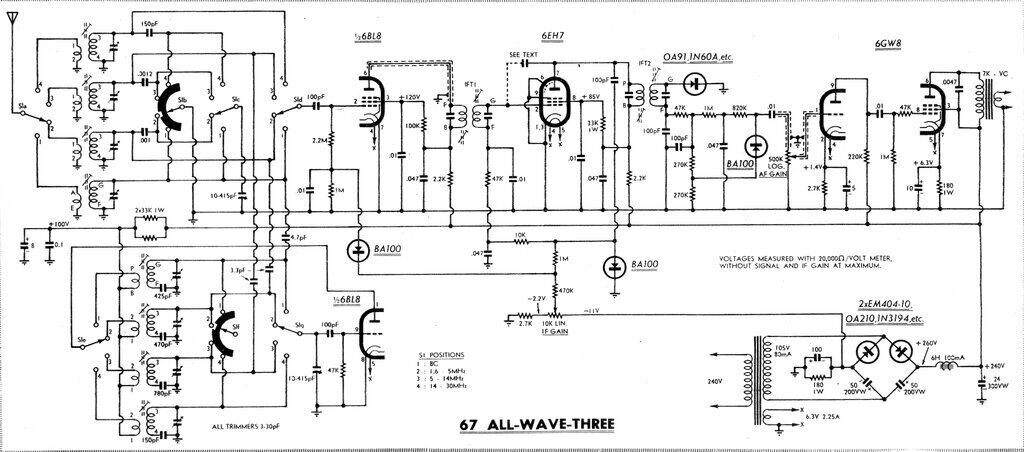
6BL8 as a superhet converter in this MW/SW receiver.
The frequency converter for the "67 All
Wave Three", described in Electronics Australia for August 1967 uses a
6BL8. This receiver is a very basic communications type (which was expanded
on in subsequent issues).
It covers 550Kc/s to 30Mc/s, and the IF
is 455Kc/s. For those who wish to use the 6BL8 as a converter in MW superhets,
this circuit is an obvious starting point.
A complete three band regenerative receiver
was described in Electronics Australia, October 1966. This was an update
of a design originally published in May 1957.
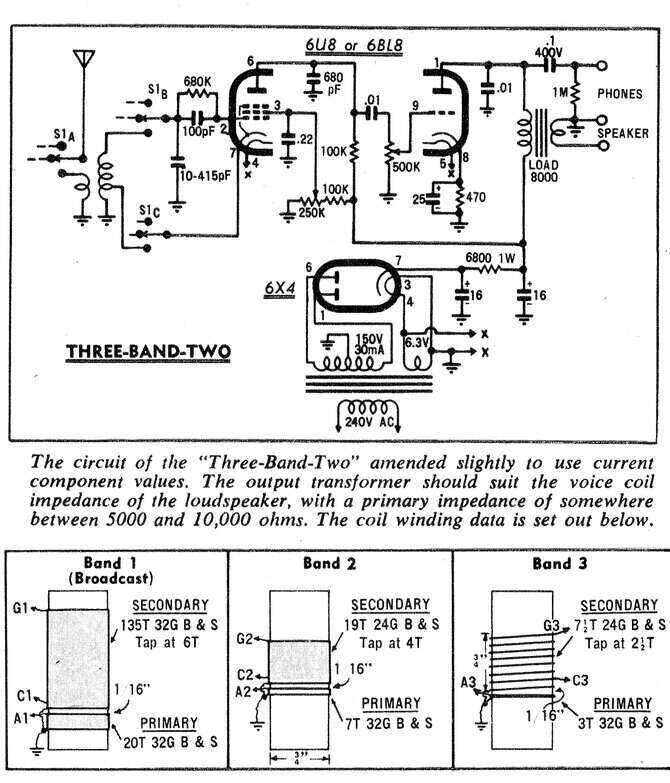
Frequency coverage is 600Kc/s-2.2Mc/s
for Band 1; 3 to 12Mc/s for Band 2, and 8 to 30Mc/s for Band 3. The basic
circuit has been adapted for numerous other projects, some of which have
been described on this site:
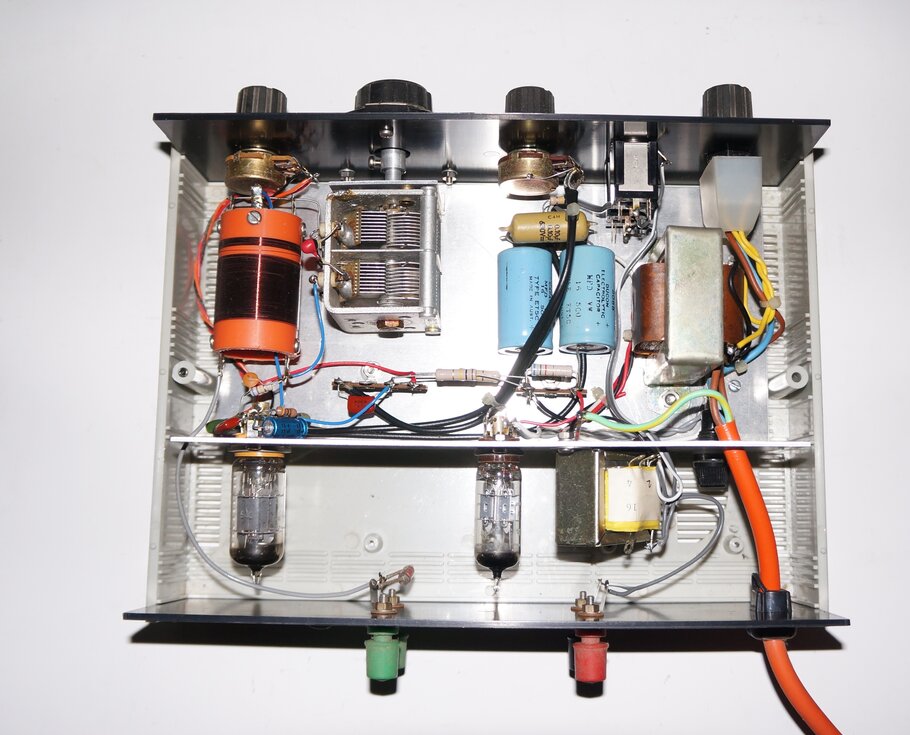
VHF Receiver Applications.
A super-regenerative receiver for the
VHF FM band using the 6BL8 has been described
here.
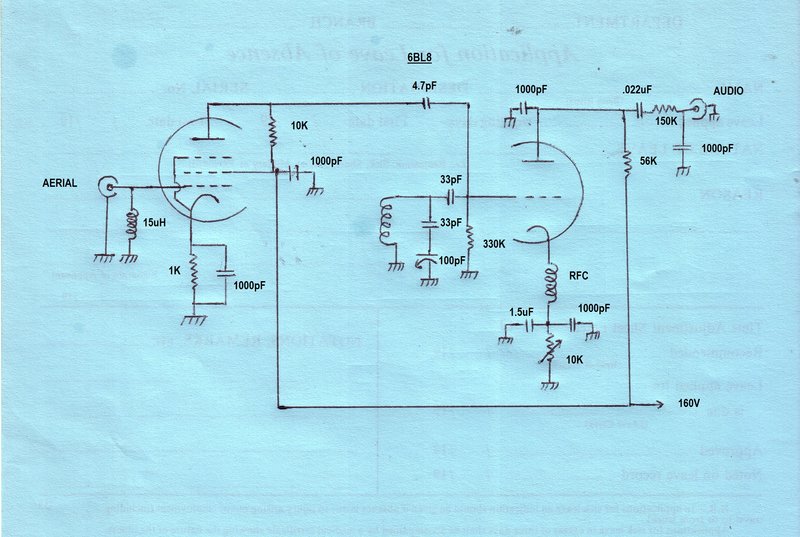
This provides VHF FM reception with line level audio output into
a high impedance load.
In most of my pulse counting FM receiver designs, a 6BL8 has been used as a grounded grid RF amplifier and autodyne frequency converter. IF is about 200Kc/s. Note that due to the construction of the 6BL8, this is not an ideal way to use the valve. There is a shield between the triode and pentode sections, which is internally connected to the pentode cathode. Normally, as the 6BL8 was designed, the pentode cathode would be earthed, and the shield would work as intended. However, in this circuit, the pentode cathode is live at RF in order to cause oscillation. There is, therefore, some capacitive coupling from the triode plate to the pentode cathode. This was not realised at the time I designed the circuit, but nevertheless, in practice it does work. See the pulse counting receiver article here.
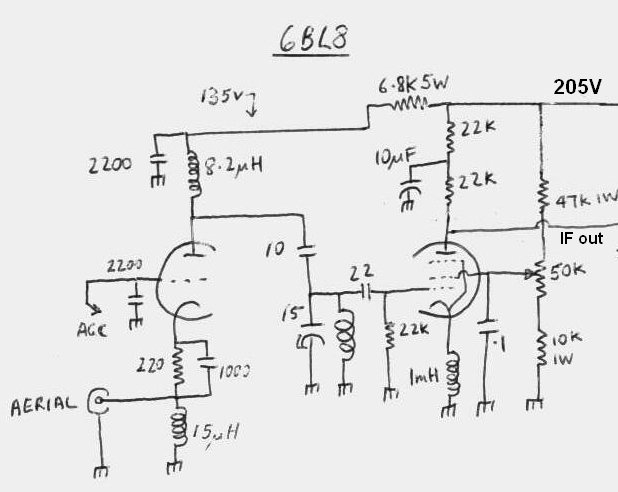
RF amplifier and frequency converter used in the VHF pulse counting
FM receivers.
A commercially made FM receiver, made by
Rogers, is described
here and uses the 6BL8 as a frequency converter in the recommended
circuit:
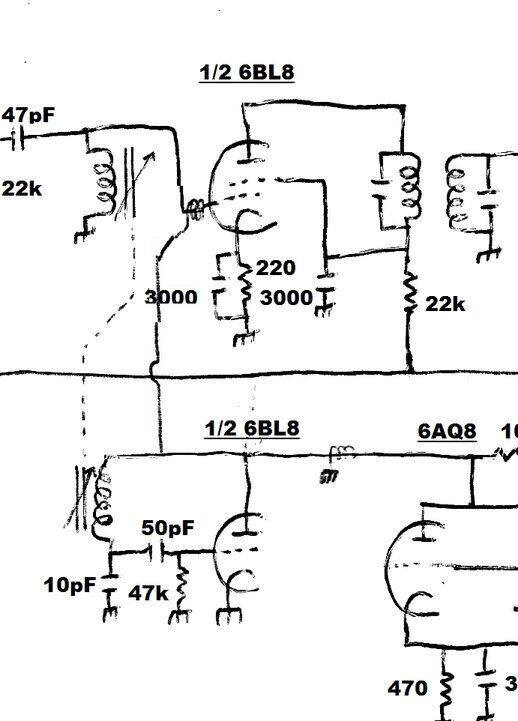
Frequency converter from the Rogers FM tuner. The 6AQ8 is part of
the AFC circuit.
Electrostatic Timebase.
This was described in Wireless World for
September 1959.
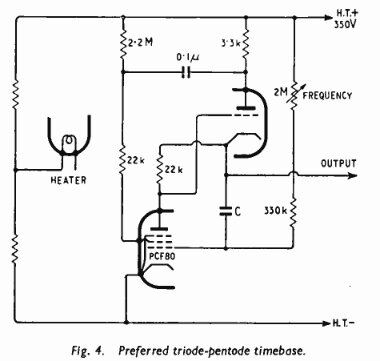
The circuit was designed for electrostatic
CRT's and operated up to 100Kc/s. Its virtue was a very fast flyback time
and high output (250Vp-p). The article describes its development and various
adaptations of the circuit, as well as methods of synchronisation.
See Wireless World at the World
Radio History site.
6U8 is a U.S designed valve which
appeared in 1953. The European type number is ECF82. The 300mA series heater
type is 9U8/PCF82. It too was intended as a TV tuner frequency converter,
and
like the 6BL8, ended up being used for all sorts of other
applications.
6CQ8 is very similar to the 6U8,
except that the pentode is a tetrode. In fact, the valve has often been
labelled 6CQ8/6U8.
6EA8 is a later improvement to
both these valves and can be used as a direct replacement.
6GH8 was used in U.S. colour receivers,
mostly for colour demodulation. This valve did appear in Australia, but
seems to have been used only for non TV applications.
6JW8 is a Philips valve designed
for line oscillator and AFC use, and was intended to replace the 6BL8 previously
used for this purpose. The European type number is ECF802, and the 300mA
series heater type is 9JW8/ECF802. There is also a 450mA series heater
version, 6LX8/LCF802.
| 6BL8 | 6U8 | 6CQ8 | 6EA8 | 6JW8 | 6GH8 | |
| Pentode plate voltage | 170 | 250 | 125 | 125 | 100 | 125 |
| Pentode screen voltage | 170 | 110 | 125 | 125 | 100 | 125 |
| Pentode plate current | 10mA | 10mA | 12mA | 12mA | 6mA | 12mA |
| Pentode bias | -2V | 68 ohm Rk | -1V | -1V | -1V | -1V |
| Pentode gain (umhos) | 6200 | 5200 | 5800 | 6400 | 5500 | 7500 |
| Triode plate voltage | 100 | 150 | 125 | 150 | 200 | 125 |
| Triode current | 14mA | 18mA | 15mA | 18mA | 3.5mA | 13.5mA |
| Triode bias | -2V | 56 ohm Rk | 56 ohm Rk | 56 ohm Rk | -2V | -1V |
| Triode gain (mu) | 20 | 40 | 40 | 40 | 70 | 46 |
Assuming the voltage/current/power ratings
are not exceeded, what happens if these valves are interchanged? As can
be seen, the triode characteristics vary quite widely, from a mu of 20
with the 6BL8, to 70 with the 6JW8.
For the pentode section, the gain varies
from 5.2mA/V with the 6U8, to 7.5mA/V for the 6GH8. There is also the cut
off characteristics to consider, along with internal capacitances where
RF operation is required.
Some circuits are non-critical enough
that the manufacturer will actually specify that 6U8 or 6BL8 can be used.
Others are more critical as described with this AWA
221-C set.
6BL8 works well in place of the 6JW8 used
in the Thorn S series chassis for the line oscillator. A 6JW8 was temporarily
used to replace the PCF80 sync separator / frame oscillator in a Decca
33 chassis. Although the heater power was deficient, it did work - but
the proper PCF80 was obtained as soon as possible. A 6BL8 did not work.
Evidently, the higher gain of the 6JW8 triode was enough to offset the
loss of heater power. Similarly, the sync separator was forgiving of reduced
pentode gain.
